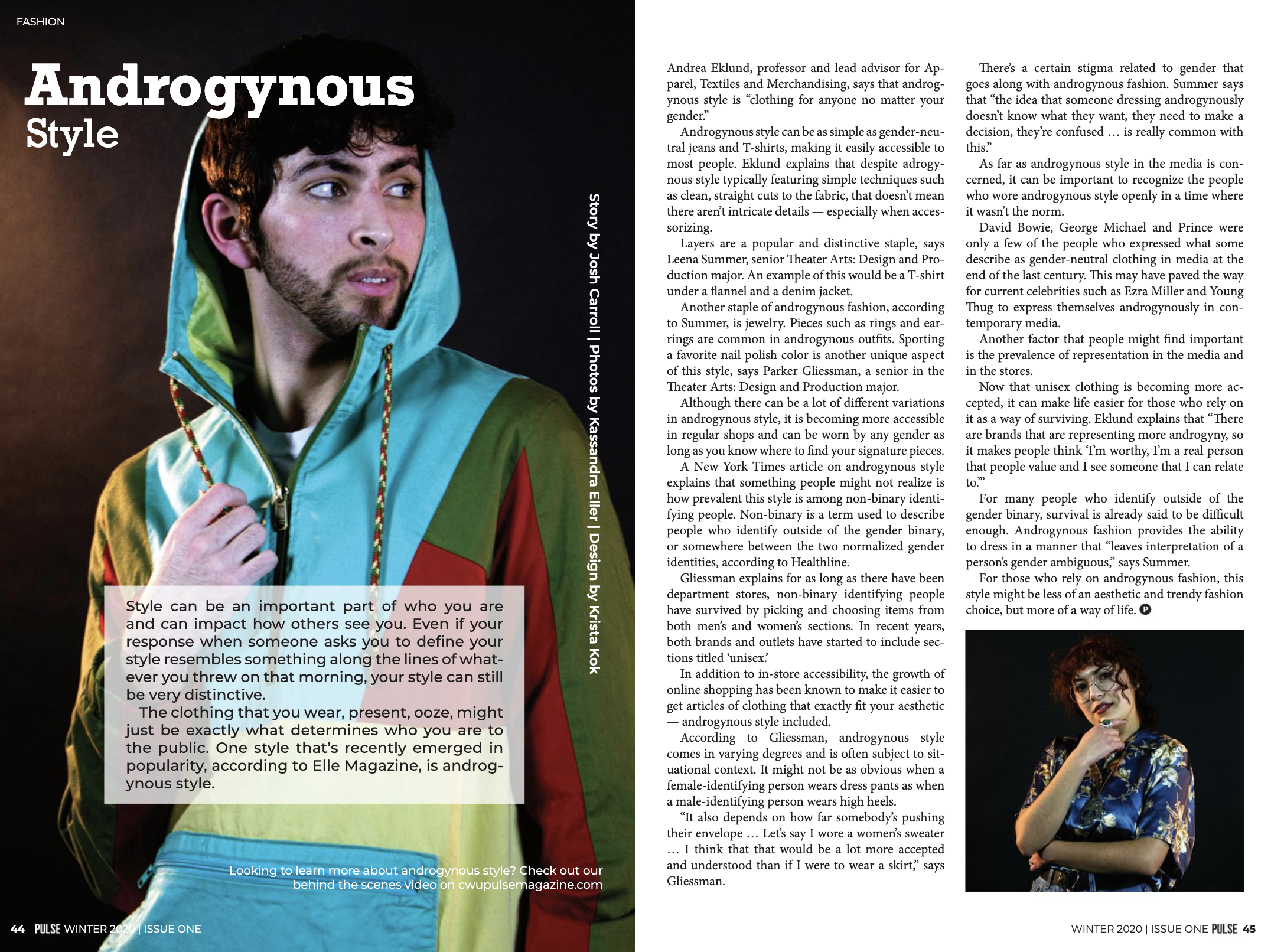Androgynous Style
Story by Josh Carroll | Photos by Kassandra Eller | Design by Krista Kok
Style can be an important part of who you are and can impact how others see you. Even if your response when someone asks you to define your style resembles something along the lines of whatever you threw on that morning, your style can still be very distinctive.
The clothing that you wear, present, ooze, might just be exactly what determines who you are to the public. One style that’s recently emerged in popularity, according to Elle Magazine, is androgynous style.
Andrea Eklund, professor and lead advisor for Apparel, Textiles and Merchandising, says that androgynous style is “clothing for anyone no matter your gender.”
Androgynous style can be as simple as gender-neutral jeans and T-shirts, making it easily accessible to most people. Eklund explains that despite adrogynous style typically featuring simple techniques such as clean, straight cuts to the fabric, that doesn’t mean there aren’t intricate details — especially when accessorizing.
Layers are a popular and distinctive staple, says Leena Summer, senior Theater Arts: Design and Production major. An example of this would be a T-shirt under a flannel and a denim jacket.
Another staple of androgynous fashion, according to Summer, is jewelry. Pieces such as rings and earrings are common in androgynous outfits. Sporting a favorite nail polish color is another unique aspect of this style, says Parker Gliessman, a senior in the Theater Arts: Design and Production major.
Although there can be a lot of different variations in androgynous style, it is becoming more accessible in regular shops and can be worn by any gender as long as you know where to find your signature pieces.
A New York Times article on androgynous style explains that something people might not realize is how prevalent this style is among non-binary identifying people. Non-binary is a term used to describe people who identify outside of the gender binary, or somewhere between the two normalized gender identities, according to Healthline.
Gliessman explains for as long as there have been department stores, non-binary identifying people have survived by picking and choosing items from both men’s and women’s sections. In recent years, both brands and outlets have started to include sections titled ‘unisex.’
In addition to in-store accessibility, the growth of online shopping has been known to make it easier to get articles of clothing that exactly fit your aesthetic — androgynous style included.
According to Gliessman, androgynous style comes in varying degrees and is often subject to situational context. It might not be as obvious when a female-identifying person wears dress pants as when a male-identifying person wears high heels.
“It also depends on how far somebody’s pushing their envelope … Let’s say I wore a women’s sweater … I think that that would be a lot more accepted and understood than if I were to wear a skirt,” says Gliessman.
There’s a certain stigma related to gender that goes along with androgynous fashion. Summer says that “the idea that someone dressing androgynously doesn’t know what they want, they need to make a decision, they’re confused … is really common with this.”
As far as androgynous style in the media is concerned, it can be important to recognize the people who wore androgynous style openly in a time where it wasn’t the norm.
David Bowie, George Michael and Prince were only a few of the people who expressed what some describe as gender-neutral clothing in media at the end of the last century. This may have paved the way for current celebrities such as Ezra Miller and Young Thug to express themselves androgynously in contemporary media.
Another factor that people might find important is the prevalence of representation in the media and in the stores.
Now that unisex clothing is becoming more accepted, it can make life easier for those who rely on it as a way of surviving. Eklund explains that “There are brands that are representing more androgyny, so it makes people think ‘I’m worthy, I’m a real person that people value and I see someone that I can relate to.’”
For many people who identify outside of the gender binary, survival is already said to be difficult enough. Androgynous fashion provides the ability to dress in a manner that “leaves interpretation of a person’s gender ambiguous,” says Summer.
For those who rely on androgynous fashion, this style might be less of an aesthetic and trendy fashion choice, but more of a way of life.



